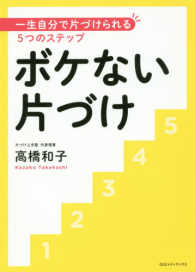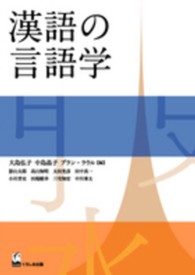- ホーム
- > 洋書
- > 英文書
- > Nature / Ecology
Full Description
This book set provides a new, global, updated, thorough, clear, and practical risk-based approach to tunnelling design and construction methods, and discusses detailed examples of solutions applied to relevant case histories. It is organized in three sequential and integrated volumes:
Volume 1: Concept - Basic Principles of Design
Volume 2: Construction - Methods, Equipment, Tools and Materials
Volume 3: Case Histories and Best Practices
The book covers all aspects of tunnelling, giving useful and practical information about design (Vol. 1), construction (Vol. 2), and best practices (Vol. 3). It provides the following features and benefits:
updated vision on tunnelling design, tools, materials, and construction
balanced mix of theory, technology, and applied experience
different and harmonized points of view from academics, professionals, and contractors
easy consultation in the form of a handbook
risk-oriented approach to tunnelling problems.
The tunnelling industry is amazingly widespread and increasingly important all over the world, particularly in developing countries. The possible audience of the book are engineers, geologists, designers, constructors, providers, contractors, public and private customers, and, in general, technicians involved in the tunnelling and underground works industry. It is also a suitable source of information for industry professionals, senior undergraduate and graduate students, researchers, and academics.
Contents
Volume 1: Concept - Basic Principles of Design 1. Introduction 2. Risk management in tunnelling 3. Input data: geology and hydrogeology 4. Input data: geotechnics 5. Environmental aspects 6. Occupational Health and Safety aspects 7. Preliminary risk assessment 8. Construction methods 9. Computational methods 10. Assessment of excavation-related hazards and design of mitigation measures 11. Monitoring during construction 12. Maintenance and refurbishment of existing tunnels 13. Project acceptance strategy. Volume 2: Construction - Methods, Equipment, Tools and Materials 1. Introduction: excavation techniques for conventional and full-face mechanised tunnelling. Reasons for the choice and differences 2. Construction methods 3. Support technology 4. Auxiliary methods technology: ground reinforcing, ground improving and pre-support technology 5. Monitoring 6. Plants and job site organization 7. Tunnel refurbishment. Volume 3: Case Histories and Best Practices Introduction 1. Metro Line C in Rome: Design and construction of the tunnels 2. Analysis of the subsidence and securing of the historical complex of Ca' Granda during the underpass by the TBM-EPB of the Milan underground metro Line 4 3. Analysis of the subsidence induced by TBM-EPB excavation during the construction of the 2o section of Milan Underground Line 5 4. Design and construction aspects of Milan Underground Line 5: Passing over the Bovisa-Dateo railway tunnel 5. Design and construction of an urban tunnel in Rabat, Morocco 6. Naples Underground Line 1 7. HS/HC railway line passing beneath Bologna city: EPB-TBM tunneling in a highly urbanized area 8. The Scianina-Tracoccia railway tunnel: The study of a complex tunnel-slope interaction 9. Venezia Station 10. The new Bressanone ring road 11. Napoli Metro - Line 6 12. Copenhagen Cityringen Metro Line: Effects of tunnel excavation on existing metro line and historical buildings 13. Brenner Base Tunnel: Soil improvement techniques in the Isarco River Underpass construction lot 14. Design of two tunnels in the Apennine area along the road SS63 "del Cerreto" 15. Conventional Tunnelling on the Follo Line Project 16. Brenner Base Tunnel: Crossing the Periadriatic Seam 17. Brenner Base Tunnel: Construction lots Aica-Mules and Mules 2-3 18. TBM excavation of schistose rock mass under high cover: Lessons learned from the Frejus Safety Tunnel 19. The Mont-Cenis Base Tunnel exploratory programme: The Saint-Martin-la-Porte and Maddalena tunnels 20. Tunnelling in a landslide-affected slope: The Val di Sambro case history 21. Sparvo Tunnel 22. Raticosa Tunnel 23. The most challenging underground project in southern Italy: Pavoncelli-bis water tunnel 24. The Terzo Valico: The new high-speed/high-capacity railway line Milano-Genova 25. Innovative soil reinforcement method for loose sand and silty ground: The construction of the new Serra dell'Ospedale twin tunnels along the Salerno-Reggio Calabria highway 26. The Caltanissetta motorway twin tunnel: A 15.08 m EPBS-TBM bore 27. Underground disposal of asbestos-contaminated muck: The case of the Cesana road tunnel (Turin, Italy) 28. Santa Lucia Tunnel 29. The Genzano tunnel of the Basento-Bradano water system 30. Favazzina Tunnel/Melia Shaft - Horizontal/Vertical excavation 31. Double-Shield TBM Tunnelling on the Follo Line Project 32. Widening the Nazzano motorway tunnel 33. Tunnel Widening: The case of Montedomini Tunnel 34. Ground freezing technique for the rehabilitation of the Cassia-Monte Mario tunnel








